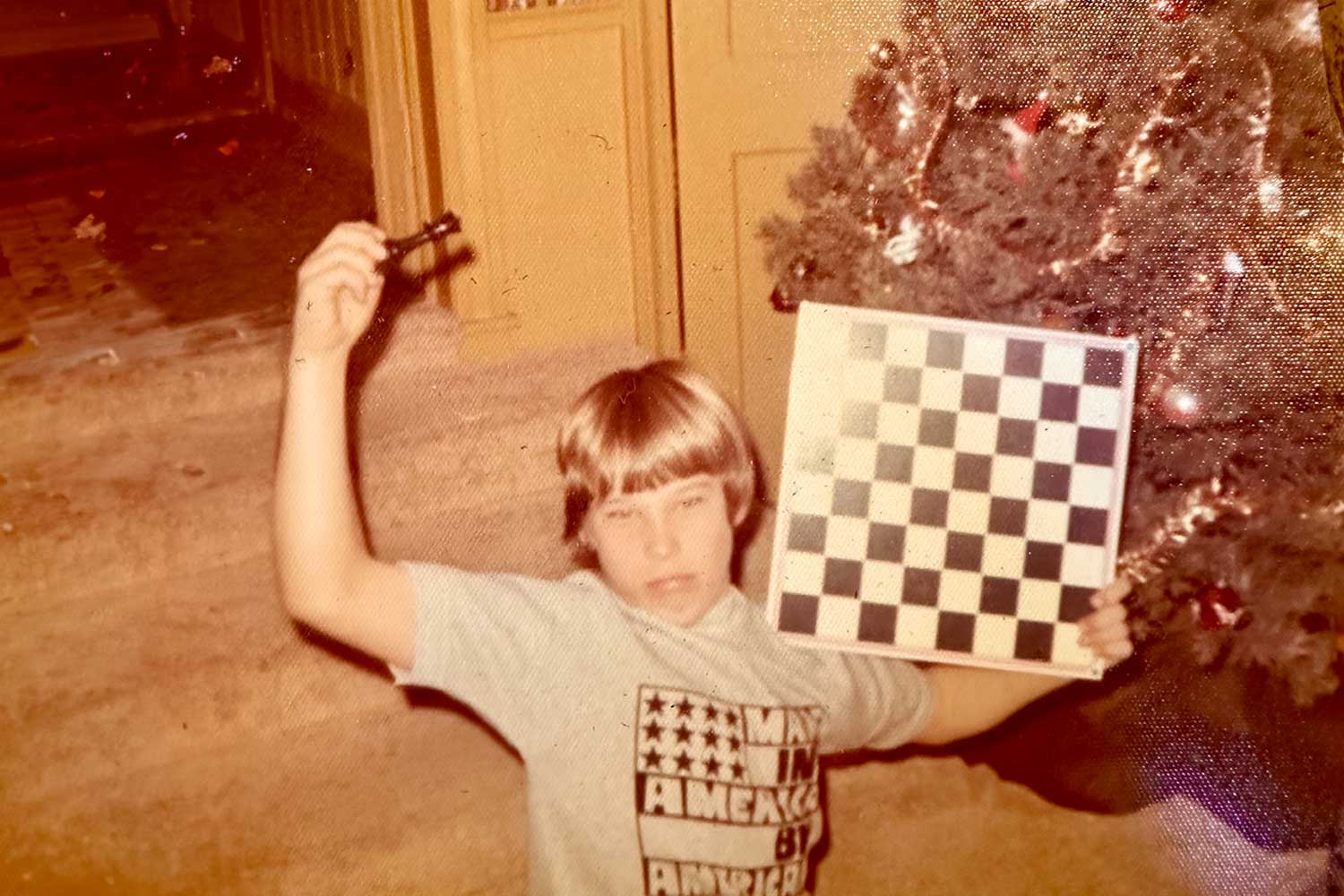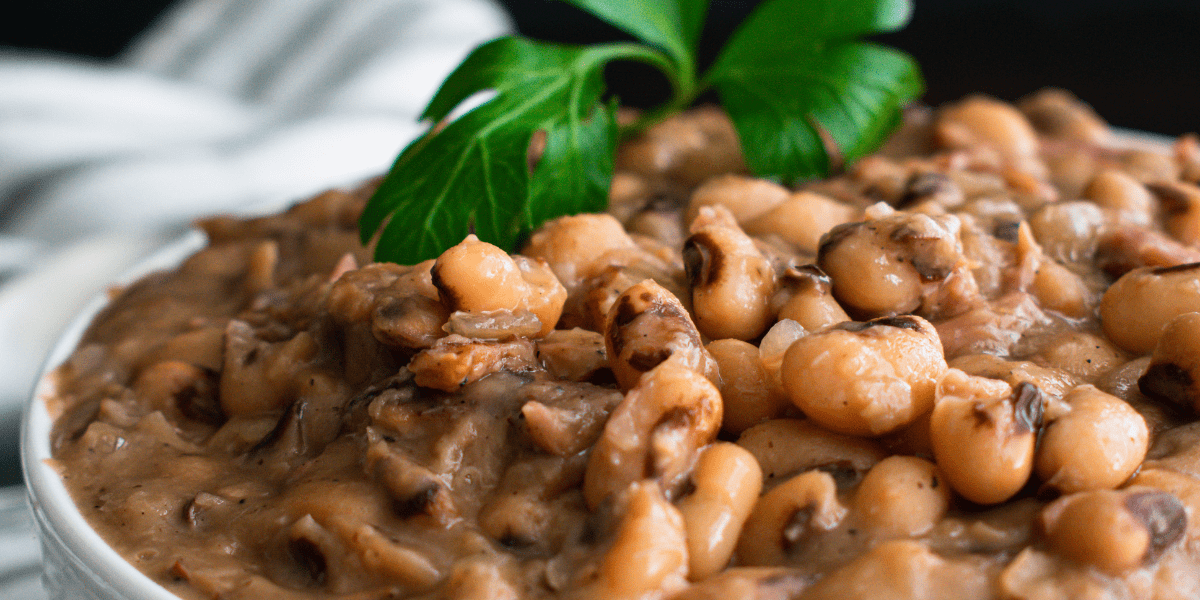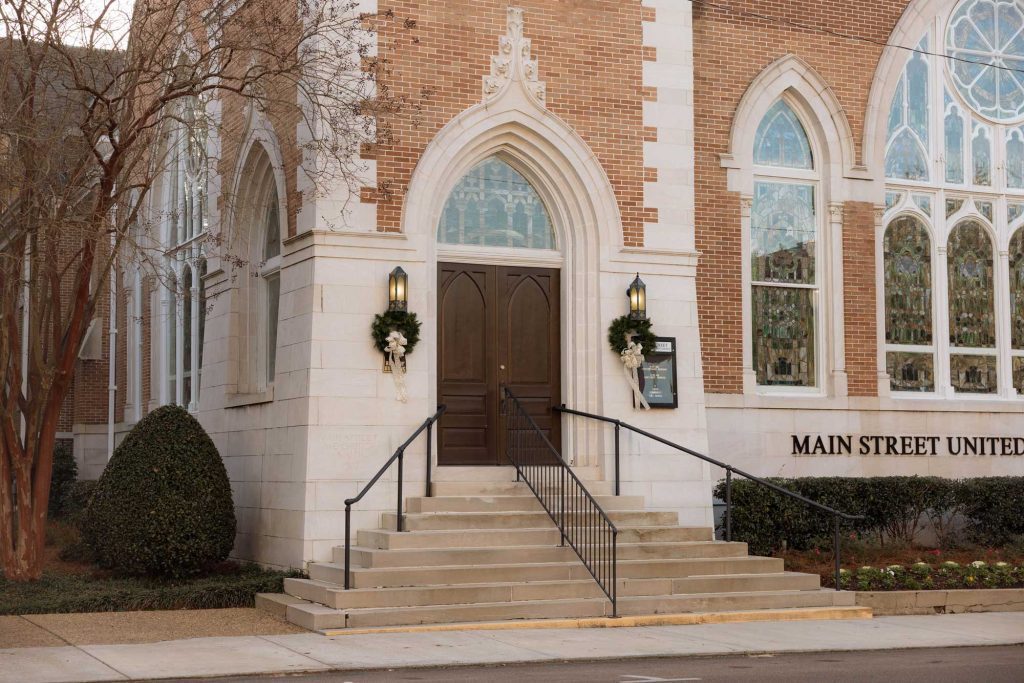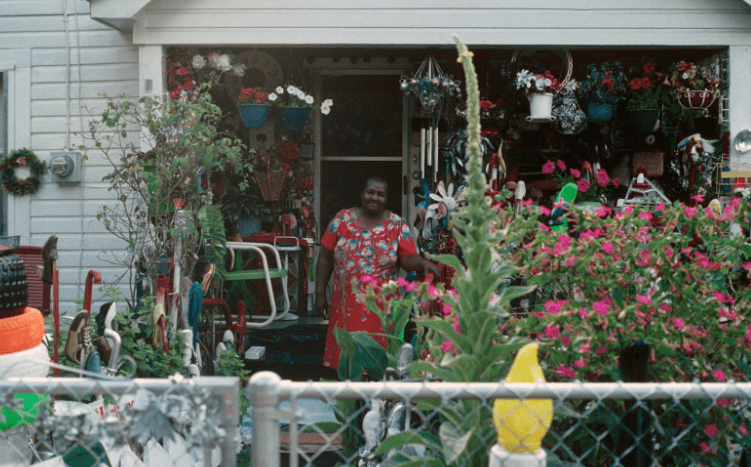
L.V. Hull standing on her front porch in front of flowers and yard display. (Photo by Pati Bingham, 1990)
Mrs. Hull died in 2008, but Kosciusko’s citizens did not forget her. Through a gift from the Kohler Foundation and the efforts of Mrs. Hull’s friends and promoters, the Arts Foundation of Kosciusko has been developing the L.V. Hull Legacy Center near her home.
L.V. Hull’s house stood on a quiet street with well-maintained single story houses occupied by African Americans in Kosciusko, Mississippi. By the 1980s, Mrs. Hull’s front yard received notice for its unusual landscaping. Rather than lawn and flower beds, there were flowering plants everywhere.
Canna lillies, four o’clocks, mullein, petunias, and begonias were intermixed with painted stacks of tires and upside-down shoes topping sticks that were dug into the ground. This unusual type of yard art led people in Kosciusko to refer to Mrs. Hull as “the shoe lady,” and some townspeople drove by the yard regularly to see any changes that this shoe lady had made.
Mrs. Hull had the best spot possible for viewing people who just drove by as well as those who parked, walked up the carpet-lined path, and knocked on her storm door. She had placed her sofa strategically so that she could watch visitors as they marveled over her yard design and front porch decorations. She then welcomed her guests inside and began a narrated tour of her astonishing home that she sometimes described as a “show off place.”

Behind the sofa and on all walls and surfaces of Mrs. Hull’s living room were her collection displays—of glass bottles, vases, wooden figures, crocheted flowers, candle holders, almost everything—often grouped in sets of two and cleaned or polished if the material allowed. When her visitors seemed ready to move on, Hull guided them on a narrow pathway through the rest of her house, often pointing out a favorite or new item and explaining its origin and significance. Each of the three bedrooms had a bed indicating its traditional household purpose, but the rooms also served as separate galleries in what appeared to be the homeowner’s carefully curated live-in museum.
The kitchen was perhaps the most startling of Hull’s home galleries. While several different sets of food-oriented ceramics and glassware occupied every surface and space on the wall, Hull kept at least one burner available for preparing meals from scratch. Even the walls and surfaces in the small bathroom held washing machine parts and other items referring to the cleaning purpose of the room, yet all fixtures were available for their intended function.
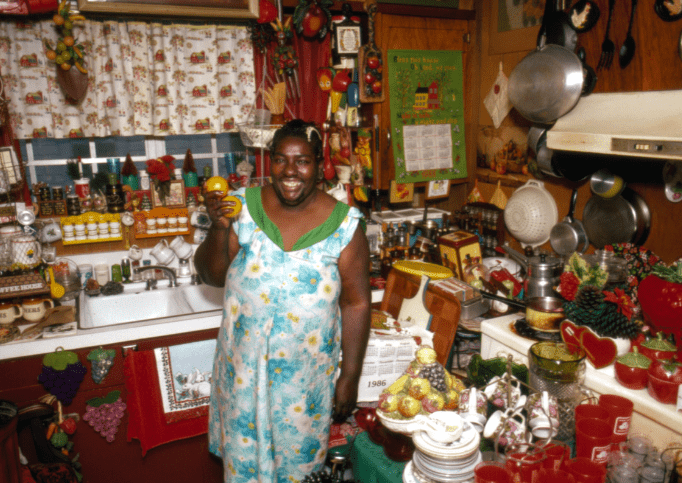
Along with expressing herself through her arrangements of collected items, at some point Hull began creating discrete pieces of art by gluing pieces of jewelry, cigarette lighters, and other small objects onto wooden backings. She presented some of these art works, which she called “plaquettes,” to local merchants like the pharmacist in exchange for favors done. She made other collage-like plaquettes available for purchase by her growing number of visitors.
By the 1990s, Hull’s home and yard had become a destination for these visitors. People came from throughout the South as well as distant locations, with a surprising number arriving in tour buses from Germany. They had heard about this African American artist whom people described variously as “folk,” “outsider,” “visionary,” “vernacular,” “environmental,” or simply “self-taught.”
Hull came to rely more on paint than three-dimensional collage to satisfy her guests’ demands for mementos of their visits. Often, she painted her favorite sayings on her plaquettes. One such saying was “Do not try to understand me. Just love me.” To further embellish her plaquettes, Hull began to paint single-stroke dots around the sayings as well as on plates, bottles, hats, hubcaps, and the shoes that still played a major part in her front yard design.
Born in 1942 in McAdam, Mississippi, L.V. (Bentley) Hull and her sister Q.T. (Bentley) Tinnin grew up in a hardworking African American sharecropper family. They picked cotton alongside her father, Joe Callie Bentley. The young L.V. also accompanied her mother, Lue Willie Bentley, on midwifery jobs. Hull spoke proudly of finishing high school and of working hard for most of her life as she cleaned, cooked, ironed, and babysat for white women in Kosciusko. Her pride shone brightest, however, when she told the story of her 1974 purchase of her Kosciusko home—quite an achievement for a single woman (she had divorced by this time) earning her living with home-centered work.
We may wonder how seemingly ordinary people such as L.V. Hull, who have no art training and little exposure to established art institutions, develop astonishing artistic interests and abilities. The how may never be understood, but for Mrs. Hull we can guess about the why. Personal tragedy very likely contributed to her focused art work. Her son, “Little Joe” Hull, was born in 1964 and died only four years later. This loss and Hull’s subsequent mourning and feeling of loneliness, combined with some health problems, probably contributed to her pursuing the artistic activities that she considered a form of meditation and a gift from God.
Journalists and other writers from Jackson and beyond helped spread the word that Kosciusko had an imaginative artist’s house worth traveling to see, but fortunately Mrs. Hull also received strong local acclaim during her lifetime. A drugstore and a clothing store on the town square and the visitor’s center off the Natchez Trace Parkway all displayed her art works prominently. Mrs. Hull also received an award from Kosciusko’s Chamber of Commerce and got a standing ovation when accepting it.
Mrs. Hull died in 2008, but Kosciusko’s citizens did not forget her. With the blessing of Mrs. Hull’s sister, friends and town leaders preserved many of the art works and archival items from her home. Recently, through a gift from the Kohler Foundation and the efforts of Mrs. Hull’s friends and promoters, the Arts Foundation of Kosciusko has been developing the L.V. Hull Legacy Center near her home.
Also, filmmaker Yaphet Smith has produced a one-hour documentary about Mrs. Hull, “Love is a Sensation,” which is now in postproduction. Smith has also purchased the original L.V. Hull home with hopes of saving and reviving it. The National Trust for Historic Preservation has named the home one of America’s 11 Most Endangered Places for 2023. We’ll stay tuned for the exciting Legacy Center opening.




